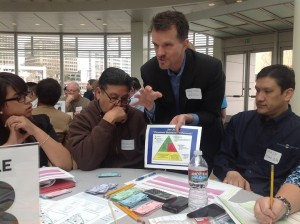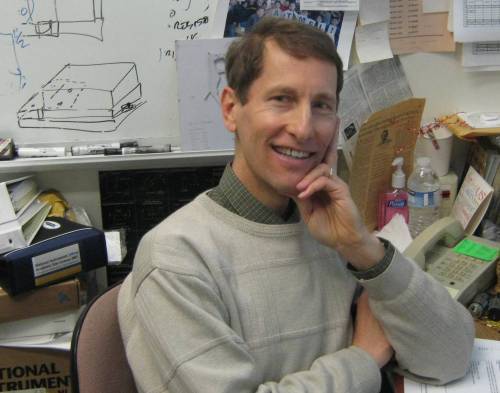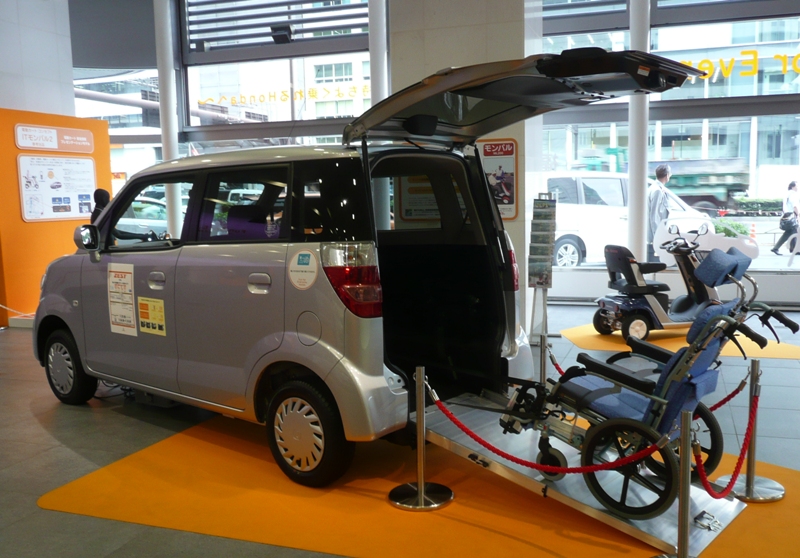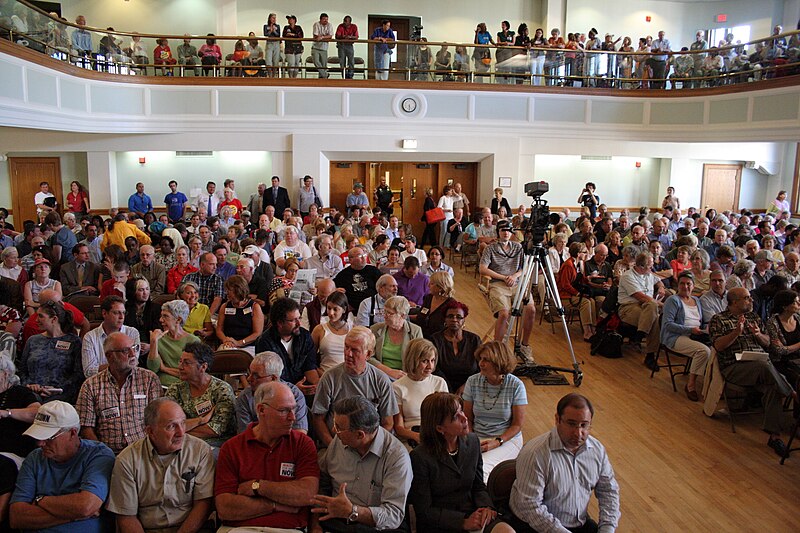As usual, many of the things that changes our world start in Silicon Valley. Today the Podcar/ATN community experiences a dramatic increase of interest from universities and cities in The Valley. Under leadership from Ron Swenson of INIST, seven cities and three universities now collaborate in moving the technology and good use of sustainable transportation forward. Today almost hundred people - including sixty students - asks themselves how we can make a better way of getting around in the 21st century using renewable energy. These people have started to organize themselves - cities starts forming an interim board and first charter, universities collaborates between the states and international borders, and not least - the main businesses are catching on. The outlook into 2014 is getting promising and exciting. I present just a few of the many that want to make a change here and now.
Hans Larsen, Transportation Manager City of San Jose. One of the many leaders involved in the work for a better transportation solution.
Burford Furman, professor at San Jose State University.
Donna Maurillo, Communications and Special Projects Director, Mineta Transportation Institute.
Mayor Tony Spitaleri, City of Sunnyvale, California
Transportation is the basic tool for peaceful human evolution and interaction. However, today's technology for travel is causing us numerous problems regarding the environment, congestion, accidents, wars and use of valuable land. I believe that by clever engineering and open minds that we can create sustainable transportation for all.
Translate
Monday, December 2, 2013
Monday, August 12, 2013
Democracy, Equality and Mobility
To travel is not for everyone. For some, it's because they don't want to. However for most people travel is essential in their everyday life, but some can't. This is for many different reasons - age, financial, health or other disability. Some people are not even allowed to travel due to political reasons.
Over the years I have been confronted with some opposition to automated transit networks with the argument "it will just add to the current traffic issues". Well, I think it is to some extent true. Or, to be more precise, I still think that an ATN system will reduce the load of other systems, cars or public. However, I do agree that it will actually add the total numbers of travel. This is due to the fact that ATN systems treats people more equal than other modes of transit. You don't need a timetable, driving license or special equipment to use a wheel chair in the Podcar. So for a lot of people who had issues traveling before, it is now considerably easier to move around. So yes, it will add to the current traffic, and that is a pretty good thing, not to forget to mention that it's the law in USA:
http://www.ada.gov/
Mobility is also about democracy and political influence. If you can't get to where decisions are made, you likely will not be heard either. This mostly affects those that have disabilities, no driving license or can't afford a car. Yes, you can go to a local meeting on a bus or light rail. But will it take you back home if the meeting goes on for a long time into late evening? Unfortunately not. So, you have to say "bye" way before the end of the meeting to catch your ride home and you are at risk not to be included in last minute decisions and forward planning. An ATN system can, like no other public transit technology, adapt to personal needs and give full service regardless of time of day, financial status or physical disability.
Over the years I have been confronted with some opposition to automated transit networks with the argument "it will just add to the current traffic issues". Well, I think it is to some extent true. Or, to be more precise, I still think that an ATN system will reduce the load of other systems, cars or public. However, I do agree that it will actually add the total numbers of travel. This is due to the fact that ATN systems treats people more equal than other modes of transit. You don't need a timetable, driving license or special equipment to use a wheel chair in the Podcar. So for a lot of people who had issues traveling before, it is now considerably easier to move around. So yes, it will add to the current traffic, and that is a pretty good thing, not to forget to mention that it's the law in USA:
http://www.ada.gov/
Mobility is also about democracy and political influence. If you can't get to where decisions are made, you likely will not be heard either. This mostly affects those that have disabilities, no driving license or can't afford a car. Yes, you can go to a local meeting on a bus or light rail. But will it take you back home if the meeting goes on for a long time into late evening? Unfortunately not. So, you have to say "bye" way before the end of the meeting to catch your ride home and you are at risk not to be included in last minute decisions and forward planning. An ATN system can, like no other public transit technology, adapt to personal needs and give full service regardless of time of day, financial status or physical disability.
Friday, June 21, 2013
Innovation and Incremental development
If you raise your view from the ground and look at transportation from above you will observe a few things. First, it's a steady flow of objects carrying people and goods constantly burning fossil fuels to move. Second, the patterns of flow is very similar to that of small water creeks turning into small rivers turning into a big massive flood of water.
Now, let's reverse the view and be a part of this flow. We are going from one place to another, either chained to the steering wheel and trying to find a way to get rid of our car when we arrive at our destination - or using public transit and trying to match timetables and routes in a way that does not mess up our precious time too much.
In this context I raise the issue again - Real Innovation in transportation can not come from within the existing modes. Anything that does that will always be limited to the current paradigm and can never break out of the box it´s put in.
Close you eyes and imagine a six lane congested freeway. Put in a little "innovation", let's say they are all now electric vehicles. Any difference? Not really. Let's add some more - imagine all of them being automatic driven by computers? It will still look the same, but maybe the people trapped in those cars at least can use their time working with their laptop or something. I don't object to electric self driving cars at all, I think it's great that this evolution is happening. But it is incremental development within the current paradigm of city development - same roads, same parking issues, almost same accident problems, still congested roads and not least - a lof of energy misused for personal transportation.
The possibilities of solar powered Automated Transit Networks is far beyond the limitations of current technologies. We can get around way safer, faster, comfortable, greener and use land for what is should be used for - humans, not machines. I am going to Los Angeles at the end of June to meet with people looking into just that at a gathering hosted by Aerospace Corporation, the Mineta Transportation Institute and City of San Jose. An update will come soon at this blog.
Now, let's reverse the view and be a part of this flow. We are going from one place to another, either chained to the steering wheel and trying to find a way to get rid of our car when we arrive at our destination - or using public transit and trying to match timetables and routes in a way that does not mess up our precious time too much.
In this context I raise the issue again - Real Innovation in transportation can not come from within the existing modes. Anything that does that will always be limited to the current paradigm and can never break out of the box it´s put in.
Close you eyes and imagine a six lane congested freeway. Put in a little "innovation", let's say they are all now electric vehicles. Any difference? Not really. Let's add some more - imagine all of them being automatic driven by computers? It will still look the same, but maybe the people trapped in those cars at least can use their time working with their laptop or something. I don't object to electric self driving cars at all, I think it's great that this evolution is happening. But it is incremental development within the current paradigm of city development - same roads, same parking issues, almost same accident problems, still congested roads and not least - a lof of energy misused for personal transportation.
The possibilities of solar powered Automated Transit Networks is far beyond the limitations of current technologies. We can get around way safer, faster, comfortable, greener and use land for what is should be used for - humans, not machines. I am going to Los Angeles at the end of June to meet with people looking into just that at a gathering hosted by Aerospace Corporation, the Mineta Transportation Institute and City of San Jose. An update will come soon at this blog.
Wednesday, April 24, 2013
The importance of continuity
Today I had a short visit with people at Capitol Hill to talk about the upcoming conference in Washington DC in October. For both US and European decision makers the issue of unemployment is high on the list of important tasks to address, something that ties closely into what we do at the conference and in the ATN/Podcar community. We want a lot of young people to be engaged in building their own sustainable future as infrastructure projects take a long time. Continuity is a major challenge in our work. Politicians and decision makers change, and so do we. By having a large contingent of students and backing organizations behind them we can create a strong flow of information that carries experiences and work from today into the new realities of tomorrow. So, the next item on my personal agenda is to invite motivated students to the conference and make sure we propagate the good work of the students and supporters we have today to a larger audience at the October conference. in DC.
A short other note - I was invited as a panelist and speaker for the ASES Conference in Baltimore last week. It was refreshing to see a larger audience than expected and also that the possibilities of solar energy and Podcar technology was well recieved. I look forward to continue in talks with ASES on this subject as I believe that we can support each other well.
Longworth House, Washington DC
A short other note - I was invited as a panelist and speaker for the ASES Conference in Baltimore last week. It was refreshing to see a larger audience than expected and also that the possibilities of solar energy and Podcar technology was well recieved. I look forward to continue in talks with ASES on this subject as I believe that we can support each other well.
Saturday, March 16, 2013
The Solar Component
I sometimes get the question "Why solar?" for Podcar systems. Well, there are many reasons for it. First, the sun is the most natural source of energy on earth, and it's endless free energy. Second, the electric energy derevied by PV cells is very suitable for transportation as electric motors are highly efficient. Third, we move with almost exactly the same pace as the sun shows itself - we sleep in the night and travel during the day. All of these good reasons add up to a solution that outperforms all non-renewable sources of energy for transportation. To furthermore add to the good news, todays cost for PV is more competitive than ever, and to install a PV system for a podcar network is also a sound financial investment.

"But, how can you travel when there is no sun?"
We just use the other sources of storage - hydro and wind. Since the travel patterns are much less intense during the night we need much less than during the day. For this day and time, solar energy as primary source of energy for transportation is not only a great idea, it's a very feasible and economical solution. On March 27 I will travel to the European Investment Bank to present the Uppsala preliinary ELENA application. The key component for the Podcar network proposed in Uppsals is the solar canopy over the track, feeding the system with 100% energy. It's amazing that less than 100 years after the break-through of the car that we now can seriously approach a solar based transportation system that performs better than the car. Human innovation and entrepreneurship that led us here is impressive, and it's the effort of many, many people that has made this possible. I really feel their strength and appreciation in my work, and it's an honor to carry these ideas forward.
Lastly, one example of many of the change solar energy can bring to people: The Barefootcollege

"But, how can you travel when there is no sun?"
We just use the other sources of storage - hydro and wind. Since the travel patterns are much less intense during the night we need much less than during the day. For this day and time, solar energy as primary source of energy for transportation is not only a great idea, it's a very feasible and economical solution. On March 27 I will travel to the European Investment Bank to present the Uppsala preliinary ELENA application. The key component for the Podcar network proposed in Uppsals is the solar canopy over the track, feeding the system with 100% energy. It's amazing that less than 100 years after the break-through of the car that we now can seriously approach a solar based transportation system that performs better than the car. Human innovation and entrepreneurship that led us here is impressive, and it's the effort of many, many people that has made this possible. I really feel their strength and appreciation in my work, and it's an honor to carry these ideas forward.
Lastly, one example of many of the change solar energy can bring to people: The Barefootcollege
Tuesday, January 8, 2013
New year, new energy and new people.
The World of Sustainable Transportation is stronger than ever. Since last year we have seen a dramatic growth in interest from Universities in all over the world. It's amazing. Here are selected bits from last year's happenings:
Sweden
The University of Linkoping recently finished a study of how to find the best route forward in getting financing for the GTS Foundation. http://www.gtsfoundation.se/english/
Ångström Laboratories, a part of the Uppsala University, now have seven students under the leadership of grad student Hanna Jansson in researching possibilities and challenges of solar as main energy source for the planned Uppsala Podcar System. http://www.asc.angstrom.uu.se/en/
 Hanna Jansson
Hanna JanssonLund University and the LUMES program student Aurora Lindström (yes, my daughter), were instrumental in structuring the Solar Skyways Challenge for San Jose University together with Professor Burford Furman.
http://www.lumes.lu.se/
USA
The San Jose State University has launched the Solar Skyways Challenge, an impressive incentive to win the $10,000 prize to best team presentation of a high quality study in making a solar podcar system. The team has its own homepage: http://www.engr.sjsu.edu/smssv/team.html
The challenge is also one of the KATERVA nominees:
http://katerva.org/2012-nominees/solar-skyways/
UK
Professor Paul Newman of Oxford University is looking into the Robotics aspect of the ULTra system at Heathrow Airport. This work is essential for understanding of the control systems and human-machine interface.
http://www.robots.ox.ac.uk/~mobile/wikisite/pmwiki/pmwiki.php?n=People.PMN
China
A "Personal Rapid Chair" video was recently posted on Youtube. It was developed by Hu Yingping at North China University of Technology:
This is just a very short list. The interest and understanding of the need for something better
than current transportation modes is getting really strong. I am sure we will have a very
exciting 2013.
Subscribe to:
Posts (Atom)








